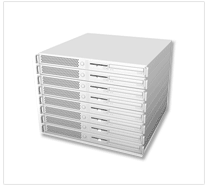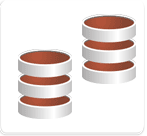![]()
RAID Server Recovery |
|
| Home > Data Recovery Services > RAID Server Recovery | |
 |
RAID is an acronym which stands for Redundant Array of Inexpensive Disks or redundant array of independent disks, a technology that allowed computer users to achieve high levels of storage reliability from low-cost and less reliable PC-class disk-drive components, via the technique of arranging the devices into arrays for redundancy. The different architectures are named by the word RAID followed by a number, as in RAID 0, RAID 1,RAID 5… etc. |
When multiple physical disks are set up to use RAID technology, they are said to be in a RAID array. This array distributes data across multiple disks, but the array is seen by the computer user and operating system as one single disk or volume. RAID can be set up to serve several different purposes. There are various combinations of these approaches offering benefits ( and trade-off as well ) on protection against data loss, capacity, and speed. RAID levels 0, 1, and 5 are the most commonly found, and cover most requirements. ADRC is proficient and adept in handlling all levels of Raid Array |
|
Raid Level 0RAID 0 (striped disks) distributes data across several disks in a way that gives improved speed at any given instant. If one disk fails, however, all of the data on the array will be lost, as there is neither parity nor mirroring. However I/O performance is greatly improved by spreading the I/O load across many channels and drives. Very simple design and easy to implement. Note that raid 0 is not a "True" RAID because it is NOT fault-tolerant and the failure of just one drive will result in all data in an array being lost and should never be used in mission critical environments. |
|
RAID Level 1RAID 1 mirrors the contents of the disks, making an exact duplicate in realtime backup. The contents of each disk in the array are identical to that of every other disk in the array. 100% redundancy of data means no rebuild is necessary in case of a disk failure, just a copy to the replacement disk. |
|
RAID Level 5RAID 5 (striped disks with parity) combines three or more disks in a way that protects against data loss of any one disk. The storage capacity of the array is reduced by one disk. One of the most popular RAID levels, RAID 5 stripes both data and parity information across three or more drives.It uses a distributed parity algorithm, writing data and parity blocks across all the drives in the array. RAID Level 5 requires a minimum of 3 drives to implement. |
|
The need for raid recovery services |
|
 |
Raid server storage is the most valuable assets of your company. People tend to neglect back up on critical data believing the myths that since raid array ( especially Raid 5) has incoporated with fault tolerance and redundancy. Therefore the possibilities and chances of disks failure and subsequently data loss issues will no longer be in existence. However even the most well designed systems are susceptible to malfunctions and RAID systems can hardly be an exception to this rule. There's a litany of reasons that can cause a RAID system failure .. |
When a business RAID storage server system first fails, it can be the beginning of an unfolding catastrophe, if lost data is not recovered in the shortest possible time. The damage and losses caused by such failures are not only disruptive to productivity, but the down time and outage can also often have huge financial consequences if not quickly remedied. At ADRC, we understand this and have rescued many small, medium and large enterprise businesses from data losses resulting from various types of RAID and network storage server media failure outages. Our in-lab RAID Array Data Recovery services and critical response data recovery professionals can quickly assess the situation and provide relevant advice and guidance on how to best address the specific data situation. Once in possession of the server or RAID disks set, our recovery specialists will quickly do an evaluation on the damaged raid array and a confirm quote will then be submitted for user’s approval. Once approval has been granted, necessary arrangement at our facilities will be made to salvage and recover your data in order to reduce organizational downtime minimising financial losses. Our highly proficient and skilled team of RAID recovery professionals can handle even the most challenging of RAID recovery scenarios. We can recover data from all types of raids ( raid 0, raid 1, raid 5 or multiple level raid 1+0, 5+1……) and file servers, application servers, web servers, network attached RAID storage devices ( NAS ), and SAN systems failures. ADRC, the unsurpassed and proficient Raid array recovery specialist in Kuala Lumpur, Selangor Malaysia and Singapore |
|

